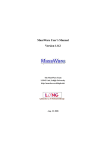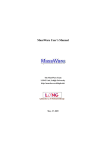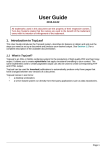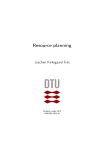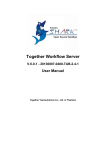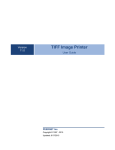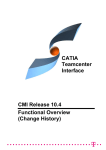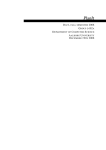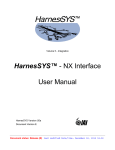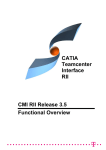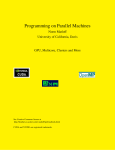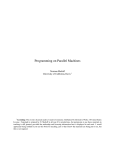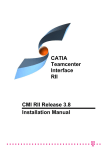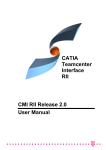Download VAASAN AMMATTIKORKEAKOULU
Transcript
Nam Hai Vu
TEAMCENTER
ENVIRONMENT REPORTER
Information Technology
2014
VAASAN AMMATTIKORKEAKOULU
UNIVERSITY OF APPLIED SCIENCES
Information Technology
ABSTRACT
Author
Title
Year
Language
Pages
Name of Supervisor
Nam Hai Vu
Teamcenter Environment Reporter
2014
English
66 + 6 Appendices
Ghodrat Moghadampour
The objective of this thesis was to develop an application which can seek
customizations in a Teamcenter environment and create a report about them.
Teamcenter is a tool for product data management. Its customizations are
Teamcenter library, plugin, workflow, query, preference, XML rendering stylesheet
and data model template.
The idea of this project is originated from IDEAL PLM to have a tool for collecting
Teamcenter customization data. It gives project managers an overview of
completed customizations when working with a new environment project. Based
on the report, they can estimate working times needed for the whole project more
accurately and efficiently.
The Teamcenter Environment Reporter consists of two parts, a Windows
application implemented in C# .NET and a helper module implemented in C
language. The helper module works as an intermediator which takes care of
communication between the Windows application and Teamcenter. The application
uses Teamcenter libraries and utilities to process data. At the end of the process,
required data will be delivered to the user as a report in HTML format and as a zip
package containing all accumulated customizations.
All require functions for the application were successfully implemented and all
objectives were achieved. The application is presented to IDEAL PLM and waiting
to be used in the near future.
Keywords
Teamcenter, Teamcenter customization, Environment reporter
PREFACE
It has been three years since I started my degree in Information Technology at Vaasa
University of Applied Sciences. During the time, I have not only learned invaluable
IT knowledge such as software developing and testing, but I also have improved
my interpersonal skills every time working in team with other classmates in a
project. Combining everything together, I successfully manage to deliver my final
project as my thesis.
The project, started from July 2014 and finished in October 2014, was inspired by
my CTO Olli Väätäinen at IDEAL PLM. In the company, I have got invaluable
first-hand working experiences in software industry. Therefore, I would like to
thank Olli for giving me this very interesting chance. Also, my thank goes to Dr.
Ghodrat Moghadampour for his supervising of this thesis.
TABLE OF CONTENTS
1
INTRODUCTION .......................................................................................... 10
1.1 Client Organization (IDEAL PLM) ........................................................ 10
1.2 Teamcenter .............................................................................................. 10
1.3 Current situation...................................................................................... 10
1.4 Teamcenter Environment Reporter ......................................................... 11
2
TECHNOLOGY ............................................................................................. 12
2.1 Teamcenter .............................................................................................. 12
2.1.1 Teamcenter API .......................................................................... 12
2.1.2 Teamcenter Customizable components....................................... 12
2.2 .NET Framework .................................................................................... 13
2.3 C# ......................................................................................................... 14
2.4 Visual Studio........................................................................................... 14
2.5 HTML & CSS ......................................................................................... 15
2.6 XML........................................................................................................ 15
3
TEAMCENTER ENVIRONMENT REPORTER ......................................... 16
3.1 General description ................................................................................. 16
3.2 Functional description ............................................................................. 17
3.3 Application Class View .......................................................................... 20
3.3.1 Individual class view ................................................................... 21
3.3.2 Task Class View.......................................................................... 28
3.4 Detailed functional description ............................................................... 31
3.4.1 Collecting DLL ........................................................................... 31
3.4.2 Collecting JAR ............................................................................ 32
3.4.3 Collecting Preference .................................................................. 33
3.4.4 Collecting Query ......................................................................... 34
3.4.5 Collecting Workflow ................................................................... 35
3.4.6 Collecting XML Rendering Stylesheet ....................................... 36
3.4.7 Collecting Data model template name ........................................ 37
4
IMPLEMENTATION .................................................................................... 38
4.1 Graphical User Interface ......................................................................... 38
5
4.1.1 Main Tab ..................................................................................... 38
4.1.2 DLL tab ....................................................................................... 40
4.1.3 Other tabs .................................................................................... 42
4.2 Main application ..................................................................................... 43
4.2.1 Filter ............................................................................................ 43
4.2.2 Teamcenter Utilities .................................................................... 45
4.2.3 ITK Program ............................................................................... 48
4.2.4 XML Parser ................................................................................. 50
4.2.5 Background Worker .................................................................... 55
4.2.6 HTML Report ............................................................................. 59
4.2.7 Zip Package ................................................................................. 60
5
TESTING ....................................................................................................... 62
5.1 Testing Environments ............................................................................. 62
5.2 Features to be tested ................................................................................ 62
5.3 Test strategy ............................................................................................ 62
5.3.1 Unit Test ...................................................................................... 62
5.3.2 System Test ................................................................................. 63
5.3.3 Regression Test ........................................................................... 64
5.3.4 Performance Test ........................................................................ 64
6
CONCLUSION .............................................................................................. 65
7
REFERENCES ............................................................................................... 66
APPENDICES ...................................................................................................... 68
LIST OF FIGURES, TABLES AND CODE SNIPPETS
Figure 1: List of functions provided by the application
18
Figure 2: Application class diagram
21
Figure 3: Preference class
22
Figure 4: Configuration class
22
Figure 5: Profile class
23
Figure 6: EnvironmentVariable class
23
Figure 7: Reporter class
24
Figure 8: DLLProcess class
24
Figure 9: JarProcess class
25
Figure 10: PreferenceProcess class
25
Figure 11: QueryProcess class
26
Figure 12: StylesheetProcess class
26
Figure 13: Template class
27
Figure 14: WorkflowProcess class
27
Figure 15: Utilities class
28
Figure 16: Configuration and its relation class diagram
29
Figure 17: Process classes diagram
30
Figure 18: Collecting DLL function
31
Figure 19: Collecting JAR diagram
32
Figure 20: Collecting Preference diagram
33
Figure 21: Collecting Query
34
Figure 22: Collecting Workflow digram
35
Figure 23: Collecting XML Rendering Stylesheet diagram
36
Figure 24: Collecting data model template name
37
Figure 25: Main Form
39
Figure 26: DLL tab
41
Figure 27: JAR tab
42
Figure 28: Normal filter logic
43
Figure 29: Preference filter logic
44
Figure 30: BackgroundWorker concept
56
7
Table 1: Required information ............................................................................. 19
Table 2: User selectable option ............................................................................ 19
Table 3: Major changes ........................................................................................ 64
Code snippet 1: TC environment configuration batch ......................................... 45
Code snippet 2: ExecuteCommand function ....................................................... 46
Code snippet 3: Execute export workflow command .......................................... 47
Code snippet 4: Execute export query command ................................................ 47
Code snippet 5: Execute export XML Rendering Stylesheet command ............. 47
Code snippet 6: Execute export preference from a file command ....................... 48
Code snippet 7: ITK code for extract and write workflow names to a text file... 48
Code snippet 8: ITK code for exporting a stylesheet to XML file ...................... 49
Code snippet 9: Compile commands for two ITK program ................................ 50
Code snippet 10: User selection of Teamcenter versions .................................... 50
Code snippet 11: Parse Stylesheet XML ............................................................. 51
Code snippet 12: XML data of a XML Rendering Stylesheet dataset ................ 52
Code snippet 13: Parse Preference XML............................................................. 53
Code snippet 14: XML data of a preference ........................................................ 54
Code snippet 15: Parse Query XML .................................................................... 55
Code snippet 16: BackgroundWorker configuration ........................................... 56
Code snippet 17: Add BW event handler ............................................................ 57
Code snippet 18: BW ProgressChanged event handler ....................................... 58
Code snippet 19: BW RunWorkerCompleted event handler ............................... 58
Code snippet 20: Write HTML file ..................................................................... 59
Code snippet 21: Write HTML table ................................................................... 60
Code snippet 22: 7zip command.......................................................................... 61
Code snippet 23: Make zip package .................................................................... 61
Code snippet 24: Unit Test code .......................................................................... 63
LIST OF APPENDICES
Appendix 1. Teamcenter Architecture
Appendix 2. Customization Teamcenter Architecture
Appendix 3. Running on a service
9
ABBREVIATIONS
API
Application programming Interface
BW
Background Worker
COTS
Commercial off the shelf
CSS
Cascading Style Sheet
DLL
Dynamic Link Library
GUI
Graphical User Interface
HTML
Hyper Text Markup Language
ITK
Integration Toolkit
JAR
Java archive
OOTB
Out of the box
PDM
Product Data Management
PLM
Product Lifecycle Management
SDK
Software Development Kit
SOA
Service Oriented Architecture
TC
Teamcenter
UI
User Interface
WF
Workflow
XML
Extensible Markup Language
1
INTRODUCTION
The Teamcenter Environment Reporter is a desktop application for the company
IDEAL PLM, to support users when working with Teamcenter customizations.
1.1
Client Organization (IDEAL PLM)
IDEAL PLM is a Finnish company established in 1992. The company provides
services related to PLM software and systems, including implementation,
integration, software licensing and training. Currently, the company has more than
80 employees, located in five different offices around Finland (Vantaa, Tampere,
Turku, Seinajöki and Vaasa) and Russia (Saint Petersburg). IDEAL PLM is the
representative of Siemens PLM Software and Siemens COMOS products in Finland
and Russia.
Numerous of projects have been either in progress or delivered to customers that
varies from small company to large enterprises. /1/
1.2
Teamcenter
Teamcenter is one of Siemens product lifecycle management (PLM) applications.
The software provides product data management (PDM) that helps users manage
and control all information related to the products. In addition, Teamcenter also
provides manufacturing data in the context of the product life cycle. /2/
1.3
Current situation
When starting a new project for a company, project managers and engineers often
get trouble locating previous customizations and estimating needed working time
for the project. They would have no idea about previous customizations because of
missing or undetailed documentation.
The solution is to make a tool to help project managers and engineers have more
detailed view of the new projects thus better monitoring and reducing time when
determining work and time for the new projects.
11
1.4
Teamcenter Environment Reporter
Teamcenter Environment Reporter is a windows application that can collect all
customizations of Teamcenter such as DLL files, JAR files, Preferences, Queries,
Workflows, XML Rendering Stylesheets and make a document report for the
accumulated customizations. In the end, a zip package contains all collected data
will be delivered to users and data can be imported to other environments.
The application supports current Teamcenter versions and provide clear and easy
to use GUI for users.
The application is going to be used within the company starting from next year
(2015).
2
TECHNOLOGY
The application is built based on .NET Framework and programmed in C#
language. The user interface (UI) is designed using Windows Forms which is
included in .NET Framework. To gather some information, some Teamcenter APIs
and built-in XML Parser are used.
When the application completes collecting information, a report page will be
displayed as a web page using HTML, CSS with the zip file of customizations.
2.1
Teamcenter
The standard installation of Teamcenter is a powerful application that helps to
manage product data. Part of Teamcenter's power is its adaptability to each
company's work processes and user interface preferences. /3/
2.1.1
Teamcenter API
Teamcenter provides various ways to customize depending on business
requirements, among which is Teamcenter API, an Integration Toolkit (ITK)
provided by Siemens PLM Software. ITK is based on C and used for server
customization. There are different ITK interfaces categorized by functionality for
Teamcenter customization.
Unlike C, all ITK functions return value ITK_ok(0) if successful or an integer
error code to inform if unsuccessful. Beside normal C data types, ITK also uses its
own special data type: tag_t, object in ITK defined by tag of C type. It is a run
time unique identifier isolates the client code using the object from its
representation in memory, making it safe from direct pointer access. /4/
Although there are numerous ways of customizing in Teamcenter, the tool only
focuses on main and frequently-used customizations. In the following sections they
are explained in detail.
2.1.2
Teamcenter Customizable components
Below are all components that allow to be customized in Teamcenter.
13
Teamcenter DLL file is a library which contains ITK functions written in C and
C++ that perform in Teamcenter server side.
Teamcenter plugin JAR file: The Teamcenter rich client is built on Eclipse rich
client platform (RCP) framework. Thanks to the framework, now by using Eclipse
plugin files (JAR) the Teamcenter rich client can be customized. /5/
Teamcenter workflow is an automation of business procedures that manages
products’ processes. Using workflows will improve efficiency and performance of
product life cycle management. /6/
Teamcenter query is used to find information in Teamcenter, a search criteria will
be inserted. Query is saved criteria that accelerate searches. /7/
Teamcenter Preferences are special environment variables stored in the Teamcenter
database. Customize preferences can change Teamcenter application behaviors. /8/
Teamcenter data model template contains a data model definition about business
objects and rules. Teamcenter can install many Data model templates to meet
business requirements.
Teamcenter XML Rendering Stylesheets are XML documents stored in
XMLRenderingStylesheet dataset. It defines how a dialog or panel is displayed in
Teamcenter.
2.2
.NET Framework
The .NET Framework is a programming framework for Windows application
developed by Microsoft.
Two main components of .NET framework are:
Common Language Runtime (CLR): A runtime environment that manages
compiling, executing, debugging, security…
.NET Framework class library (FCL): A library includes pre-made classes
and interfaces for users.
The .NET Framework has some main features:
Cross Language Interoperability:
Allow and support two different
programming languages on the same data structure.
Multiple platforms development: Now .NET provides different types of
application:
o Web application
o Web service
o Desktop application
o Mobile application
Memory management: CLR is responsible for managing memory
(allocating when needed and freeing up memory when done) with help of
.NET Garbage Collector. /9/
2.3
C#
C# is a programming language developed by Microsoft and included in .NET
Framework SDK. C# syntax is similar to C and Java. C# is object oriented
programming language, that means OOP concepts are encapsulation, inheritance,
and polymorphism are supported. C# runs on the .NET Framework with the help of
CLR to compile to native machine language. /10/
2.4
Visual Studio
Visual Studio is an integrated development environment by Microsoft to develop
applications in multi platforms. It contains code editor with ItelliSense to help
writing codes faster and more accurately.
Windows Forms that helps building GUI is included in .NET Framework with the
support of Visual Studio in order to help programmers in designing interface simply
just by dragging and dropping. /11/
15
2.5
HTML & CSS
Hyper Text Markup Language is a markup language for making Web pages. HTML
describes the structure and layout of a web page by using defined elements and
attributes. /12/
HTML5 is the latest version of the HTML standard with strong multimedia support
for computers and mobile devices. This HTML5 is now the recommendation of the
World Wide Web Consortium (W3C).
CSS is the language for describing the presentation of Web pages, including colors,
layout, and fonts. CSS is used to format HTML elements in order to build Web
pages with special styles.
CSS can be written inside HTML as an internal component or external as a .css file.
The latter way is more useful because it would be easier for reading and
maintenance. /12/
2.6
XML
The Extensible Markup Language (XML) is a markup language like HTML but
using own designed elements instead of using pre-defined ones. XML is targeted to
describe text data and widely used in web services. /13/
XML Parser: To read or write XML document, written XML parser is used to do
such things to save time and reduce work.
.NET Framework provides several classes for parsing XML data such as
XMLReader, XMLDocument, LINQ to XML. They have their own advantages and
disadvantages that grant programmers flexibility in usage.
3
TEAMCENTER ENVIRONMENT REPORTER
This part covers the specification of Teamcenter environment reporter application
that is resulted from collecting and analyzing requirements.
3.1
General description
The Teamcenter Environment Reporter will only be used by IDEAL PLM
employees who do not have adequate documentation or have documentation but
not completed one about previous customizations have been done in Teamcenter
previously. The resolution is developing an application can collect all of previous
customizations and make a brief report.
The application should fulfil the following requirements:
User friendly: No need to be complicated, because it will be hard for
everyone to remember console command or name of Teamcenter objects. A
desktop application with simple GUI will fulfill this requirement.
Selection for customizable parts: Users can select what type of
customizations they want to extract, the options are: DLL, JAR, XML
Rendering Stylesheet, Workflow, Query and Preference.
Report and files: A report as well as a zip file containing all customization
information is generated after each use for fulfilling this requirement
Performance: The application performance is required to work in good
amount of time even in a complicated system.
Maintenance and upgrade: The new Teamcenter version is coming so the
application needs to be well designed with clear specification. Moreover,
the message of errors is required for bug fixing.
After analyzing all requirements, the following technical specification can be
considered.
17
3.2
Functional description
The most important functionality of the application is collecting customizations and
making a report for it. Another aspect is GUI’s usefulness and simplicity.
There are requirements with different priority levels needed to be considered and
described as the below quality function deployment.
1. Must have
a. Create a report.
b. Create a zip file.
c. Have a user manual.
2. Should have
a. Selectable specific options.
b. A friendly GUI.
3. Nice to have
a. Exception handling.
b. Smart collecting
The below figure 1 is use case diagram of user interface.
Figure 1: List of functions provided by the application
The application usage is straight forward therefor
e the use case is also simple
and short.
Before clicking the Start button, users have to fill in all required information
first:
o Fill in required information for logging into Teamcenter, e.g.
Teamcenter version, account credentials.
o Input the keywords for comparing filter.
o Select what kind of customizations users want to extract, e.g. DLL
or JAR.
Read Instruction: There is an instruction to guide new users how to use the
application.
Quit application: Stop running application and exit.
This is required information related to Teamcenter environment that users need to
know and fill before using the application
19
Table 1: Required information
Required Information
Description
Required for
Preferences
Teamcenter version
Target version of running
Queries
Teamcenter
Workflows
XML Rendering Stylesheets
Username, password,
User credentials
group for logging in to
Teamcenter
Teamcenter configuration
Path for Teamcenter
path
configuration batch file
Preferences
Queries
Workflows
XML Rendering Stylesheets
DLL files
JAR files
Preferences
Queries
Workflows
XML Rendering Stylesheets
Besides, the application needs keywords that are put by users for filtering
customizations. There are two types of keywords: included and excluded keyword.
Included keywords: Search for all customizations contains included keywords.
Excluded keywords: After collecting all customizations with included keywords,
exclude the customizations containing excluded keywords.
There are 7 available options which correspond to 7 customizations for users to
select:
Table 2: User selectable option
Options
Description
DLL files
DLL file path, last modified date
JAR files
JAR file path, last modified date
Preferences
Preference name, value, description
Queries
Query name, description
Workflows
Workflow file name
XML Rendering Stylesheet
XML file name
Templates
Data model template name
Export to zip package option: This is an option if users want to have a zip file
compressing all customized files which are found and reported by the application.
If not selected, only a report is output.
3.3
Application Class View
Because different types of customizations can be made, different classes are
designed for each type of customization. In addition, other classes for the
application’s configuration, such as Teamcenter path or user credentials, are also
needed and described in following sections.
21
Figure 2: Application class diagram
To avoid strong coupling, classes must be separated and classified into two groups:
UI and logic. This means that the UI class is at the front and is not relevant to
process works. On the other hand, logic classes take care of the whole behind
business logic. The separation will make the application become more of a loose
coupling when being developed.
3.3.1
Individual class view
Preference class
Preferences are used as environment variables for Teamcenter. Two
important components of preference are preference name and preference
value. Preference value can be in different types such as string, array string
and number. With the support of Teamcenter, preferences can be exported
and imported as XML files. Hence, a class for Teamcenter preference
instance is created with similar properties to preference XML attributes.
Figure 3: Preference class
Configuration class
In order to gather all users’ settings right after clicking Start button,
Configuration instance is created to store all current settings for logic to
process.
The
current
settings
are
Configuration’s
properties:
EnvironmentVariable, export, List keywords, profile, Teamcenter path, and
Teamcenter version.
Figure 4: Configuration class
Profile class
Teamcenter utilities require username, password and group when
executing commands in order to extract data from Teamcenter database.
23
This class stores users’ credentials like username, password and group
when logging into Teamcenter.
Figure 5: Profile class
EnvironmentVariable class
Unlike preferences, environment variables for Teamcenter are normal
system variables, for example, Teamcenter directory, Teamcenter data
directory, etc. These environment variables will be used to locate
compulsory directories. This class stores needed Teamcenter
environment variables.
Figure 6: EnvironmentVariable class
Reporter class
Reporter class is an abstract class. It includes protected attributes for its
children. A normal method readConfig() is used to get user input
values from UI and populate them to its attributes. Abstract method
report() is for being overridden by inherited classes. It will then return
List<string[]> type that needed for the final HTML report.
Figure 7: Reporter class
These below classes play a role as processing logic behind UI. All of them inherit
abstract class Reporter and override report() method.
DLLProcess class
This class is responsible for getting all DLL files from TC_BIN environment
variable and filter these using provided keywords. It also copies filtered files to new
location for packaging.
Figure 8: DLLProcess class
JarProcess class
This class is responsible for getting all JAR files from plugin folder of Teamcenter
and filter them using provided keywords. It also copies filtered files to new location
for packaging.
25
Figure 9: JarProcess class
PreferenceProcess class
Teamcenter preferences will be exported into an XML file. Processing, parsing,
filtering XML data is the responsibility of this class.
Figure 10: PreferenceProcess class
QueryProcess class
Query is a string used for searching specific data from the Teamcenter database
with flexibility. Similar to preference class, this class accumulates queries from
XML data.
Figure 11: QueryProcess class
StylesheetProcess class
XML Rendering Stylesheet can be customized to create or change view of
displaying Teamcenter data for example an item’s properties. XML Rendering
stylesheet methods and properties form this class.
Figure 12: StylesheetProcess class
TemplateProcess class
Dependent Data model templates for Teamcenter are stored in XML files. This
class deals with parsing XML data and make it available in the report.
27
Figure 13: Template class
WorkflowProcess class
Resembling other customizable modules, workflow can be exported into an XML
file with all information and is saved as XML data. This class handles exporting
workflow data and processing it for the report.
Figure 14: WorkflowProcess class
Utilities class
Utilities class is a group of frequent utility functions and constant variables.
Methods in this class are defined public and static. Some functions are overloaded
each other to be flexible in used.
Figure 15: Utilities class
UIForm class
The GUI class contains event handlers for UI controls such as button, textbox,
checkbox.
3.3.2
Task Class View
There are 6 tasks for 6 corresponding available options and a task for collecting all
required information:
The application will create a new instance of class Configuration from user’s inputs
including TC account information, environment variables and application
29
configurations.
Figure 16: Configuration and its relation class diagram
The application creates a new thread and this will be responsible for extracting all
Teamcenter customization information and filter them using provided keywords.
The logic for this is placed in below classes called Process classes. These inherits
Reporter class that is defined as an abstract class.
Figure 17: Process classes diagram
31
3.4
Detailed functional description
Sequence diagram is to describe interactions between the application’s components
with each other by passing messages among them.
3.4.1
Collecting DLL
The figure below describes how collecting DLL function works.
Figure 18: Collecting DLL function
1. The user selects a DLL option, clicks the Start button in UI: A new instance
of a background worker is created and added the DLL work.
2. The BW starts running.
3. The BW reports progress to the UI.
4. A new instance of DLLProcess invokes overridden report() method. The
return is a list and file paths of collected DLL files.
5. The BW adds DLL list to the HTML report.
6. The BW finishes and reports work progress to the UI.
3.4.2
Collecting JAR
The figure below describes how collecting JAR function works.
Figure 19: Collecting JAR diagram
1. The user selects the JAR option, clicks the Start button in the UI: A new
instance of a background worker is created and added the JAR work.
2. The BW starts running.
3. The BW reports progress to the UI.
4. A new instance of the JARProcess invokes overridden report() method.
The return is a list and file paths of collected the JAR files.
5. The BW adds the JAR list to the HTML report.
6. The BW finishes and reports work progress to the UI.
33
3.4.3
Collecting Preference
The figure below describes how collecting Preference function works.
Figure 20: Collecting Preference diagram
1. The user selects Preference option, clicks the Start button in the UI: A new
instance of a background worker is created and added the Preference work.
2. The BW starts running.
3. The BW reports progress to the UI.
4. A new instance of the PreferenceProcess invokes overridden report()
method.
5. The PreferenceProcess instance gets a list of customized preferences by
calling getCustomizedPreferenceList().
6. The PreferenceProcess instance exports found preferences to XML file and
returns a list of preference information.
7. The BW adds the Preference list to the HTML report.
8. The BW finishes and reports work progress to the UI.
3.4.4
Collecting Query
The figure below describes how collecting Query function works.
Figure 21: Collecting Query
1. The user selects the Query option, clicks the Start button in the UI: A new
instance of a background worker is created and added the Query work.
2. The BW starts running then reporting progress to the UI.
3. New instance of QueryProcess invokes overridden report() method.
4. The QueryProcess instance gets a list of all queries by calling
getAllQueries().
5. The QueryProcess instance exports filtered query to one XML file and
returns a list of query information.
6. The QueryProcess instance invokes separateQueryXML() function.
7. The QueryProcess separates queries one by one from an XML file, then
saves each to XML files.
8. The BW adds Query list to the HTML report.
9. The BW finishes and reports work progress to the UI.
35
3.4.5
Collecting Workflow
The figure below describes how collecting Workflow function works.
Figure 22: Collecting Workflow digram
1. The user selects the Workflow option, clicks the Start button in the UI: A
new instance of a background worker is created and added the new work.
2. The BW starts running.
3. The BW reports progress to the UI.
4. A new instance of WorkflowProcess invokes overridden method
report() method function.
5. The WorkflowProcess instance gets a list of customized Workflow names
by calling getCustomizedWorkflowNameList().
6. The WorkflowProcess instance executes an ITK program which writes all
workflow names to a text file by name.
7. The WorkflowProcess exports workflows to corresponding XML files.
8. The WorkflowProcess instance returns a list of workflow information.
9. The BW adds the Workflow list to the HTML report.
10. The BW finishes and reports work progress to UI.
3.4.6
Collecting XML Rendering Stylesheet
The figure below describes how collecting XML Rendering Stylesheet function
works.
Figure 23: Collecting XML Rendering Stylesheet diagram
1. The user selects XML Rendering Stylesheet option, clicks the Start button:
A new instance of a background worker is created and added the new work.
2. The BW starts running.
3. The BW reports progress to the UI.
4. A new instance of StylesheetProcess invokes overridden method
report().
5. The StylesheetProcess instance will create a file with a list of all Stylesheet
name by calling getAllStylesheet().
6. The StylesheetProcess instance executes an ITK program which exports
stylesheets to XML files by name.
7. The StylesheetProcess instance returns a list of stylesheet information.
8. The BW adds XML Rendering Stylesheet list to the HTML report.
9. BW finishes and reports work progress to the UI.
37
3.4.7
Collecting Data model template name
The figure below describes how collecting Data model template name function
works.
Figure 24: Collecting data model template name
1. The user selects Data model Template option, clicks the Start button in the
UI: A new instance of a background worker is created and added the Data
model Template work.
2. The BW starts running.
3. The BW reports progress to UI.
4. A new instance of TemplateProcess invokes overridden method report()
method.
5. The TemplateProcess instance returns a list of template information.
6. The BW adds the template list to HTML report.
7. The BW finishes and reports the work progress to the UI.
4
IMPLEMENTATION
This chapter is divided into 2 main parts, the GUI and the main application are
discussed in the following sections.
4.1
Graphical User Interface
Thanks to Windows Forms, now the GUI design for Windows application is much
easier than ever before. Windows Forms is a graphical API included in .NET
Framework. With the help of Visual Studio, the application’s GUI is designed with
Windows Forms controls such as textboxes, buttons, progress bars, etc. and
automatically generated action events such as mouse clicks, key presses, to name a
few, attached to those controls.
The GUI also needs to support resizing windows by separating controls into panels
and anchors. Hence it is possible to resize the application window if users get
trouble with their screen resolution.
In the application, the GUI’s target is to be user-friendly but to concentrate on the
report result. So the design is as simple as described with below steps.
1. Provide Teamcenter information (username, password, version…)
2. Provide acknowledged keywords.
3. Select supported options.
Due to different types of Teamcenter customizations, different tab views are
required:
4.1.1
Main Tab
39
The main tab is the most important tab, it consists of all controls that require input
from users.
Figure 25: Main Form
Firstly, users need to provide the application their using Teamcenter version. There
are 3 supported popular versions of Teamcenter 8.3, 9.1 and 10.1. When users select
a version, the corresponding excluded keywords will be automatically filled.
Then, users insert the account that has adequate administrator privilege.
In order to locate Teamcenter root and other profile variables, the application needs
Teamcenter configuration batch file (a .bat file contains all needed environment
variables of Teamcenter).
Users can choose a text file containing keywords or type keywords to a textbox or
both.
There are different checked boxes that allow users to select which type of
customizations they want to have. Users can also select Export checkbox and a zip
package will be delivered after the report.
At the bottom of the window, a progress bar with status label will indicate status of
the running application.
An instruction for new users with clear instructions and notes will be opened if
instruction button is clicked.
4.1.2
DLL tab
Below is a screenshot of a DLL tab.
41
Figure 26: DLL tab
There are two multiple lines textboxes, one is included keyword, the other for
excluded DLL names. The excluded keywords box is automatically loaded when
users select TC version.
Because the preference TC_customization_libraries holds most of the
customized DLL, so the user can get these DLL names by pressing Get Keyword
button under the keyword textbox. The application will ask this preference’s values
and copy these values to the textbox.
4.1.3
Other tabs
Similar to the DLL tab, other tabs such as JAR, XML, Workflow, Preference, Query
tab, have 2 multiple lines textboxes for included and excluded keywords. Excluded
keywords are automatically loaded when selecting the TC version.
Figure 27: JAR tab
43
4.2
Main application
Implementation in the main application is divided into parts which are described
and discussed here.
4.2.1
Filter
In order to collect customization data accurately, filters are needed to be applied to
every Teamcenter customizable components using included and excluded
keywords. Both included and excluded keywords are normally identified by users.
In addition, Teamcenter already has out of the box (original functionality ready to
be used) components so excluded keywords must have these OOTB names.
Therefore, included keywords and excluded keywords are displayed as multiple
lines text boxes in the GUI.
In the application, filter process algorithm for DLL, JAR, Workflow and Query is
simplified in below picture:
Figure 28: Normal filter logic
The logic for preference is described in the following figure
Figure 29: Preference filter logic
This preference case is more complex than the others because Commercial off-theshelf (the ready-made item but needs to be configured before use) preference are
usually modified. So the XMLParser has to work here to read preference content
and compare preference name, values with the COTS ones before going through
the normal sequence with included and excluded keywords.
45
4.2.2
Teamcenter Utilities
Teamcenter provides many stand-alone programs that can command directly to
Teamcenter without logging into client. It requires administrator privilege and a
configured environment command line to run.
To manually set up the Teamcenter environment, use these commands in the
command prompt line:
set TC_ROOT=Teamcenter_root_directory
set TC_DATA=Teamcenter_data_directory
call %TC_DATA%\tc_profilevar
Code snippet 1: TC environment configuration batch
Since Teamcenter always has a batch file doing the same, users only have to provide
this batch file to the application instead of making their own. The batch file is ready
under TC_ROOT/tcmenu/.
A static method named ExecuteCommand in the Utilities class is defined to run
any Teamcenter command. The first parameter is the path of the batch file, the
second
one
is
a
command.
ExecuteCommand() method.
The
following
code
snippet
described
public static string ExecuteCommand(string tcPath, string command)
{
ProcessStartInfo processInfo = new ProcessStartInfo(@"cmd");
//display command window
if (debug)
processInfo.CreateNoWindow = false;
else
processInfo.CreateNoWindow = true;
//Print all input, output and error to screen
processInfo.UseShellExecute = false;
processInfo.RedirectStandardError = true;
processInfo.RedirectStandardInput = true;
processInfo.RedirectStandardOutput = true;
string output = "";
Process process = Process.Start(processInfo);
if (process != null) {
//setting Teamcenter configuration
process.StandardInput.WriteLine(tcPath);
//write the command that is executed
process.StandardInput.WriteLine(command);
process.StandardInput.Close(); // line added to stop
process from hanging on ReadToEnd()
output = process.StandardOutput.ReadToEnd();
if (debug) {
string error =
process.StandardError.ReadToEnd();
}
process.Close();
}
return output;
}
Code snippet 2: ExecuteCommand function
With Teamcenter utilities, Workflows, Queries, and XML Rendering Stylesheets
can be exported by using command: plmxml_export. But this command is
limited to tailor-made options. Therefore, stand-alone ITK programs must be coded
to fulfill the limitations.
When exporting Workflows, plmxml_export only works if the
workflow names are already known. An ITK program can find all
Teamcenter Workflows and write them down to a text file. The application
reads text file and calls plmxml_export for each workflow.
47
//plmxml_export is used to export Workflow
Utilities.ExecuteCommand(config.tcPath, @"plmxml_export -u=" +
profile.username + " -p=" + profile.password + " -g=" +
profile.group + " -xml_file=\"" + outputFilePath + "\"" + " template=\"" + workflowName + "\"");
Code snippet 3: Execute export workflow command
When exporting Queries, plmxml_export only exports an XML file
containing all queries of Teamcenter. To separate into smaller query XML
file, XMLDocument will do the job.
// plmxml_export is used to export Query
Utilities.ExecuteCommand(config.tcPath, "plmxml_export -u=" +
profile.username + " -p=" + profile.password + " -g=" +
profile.group + " -imantypedef=ImanQuery -xml_file=\"" +
outputFile + "\"");
Code snippet 4: Execute export query command
Concerning XML Rendering Stylesheet, plmxml_export only export
XML file containing all Stylesheet dataset information under XML format.
So an XML parser and ITK program are needed to filter and export them
into individual XML files.
//plmxml_export is used to export XML Rendering Stylesheet
Utilities.ExecuteCommand(config.tcPath, @"plmxml_export -u=" +
profile.username + " -p=" + profile.password + " -g=" +
profile.group + " -type=XMLRenderingStylesheet -xml_file=\"" +
outputFilePath + "\"");
Code snippet 5: Execute export XML Rendering Stylesheet command
Regarding preference, Teamcenter Utilities provides very useful command
preference_managers located in TC_BIN directory. In order to
execute this command to export preferences in C#, these code snippets are
used.
//preference_manager is used with parameters in C#
Utilities.ExecuteCommand(config.tcPath, @"preferences_manager u=" + profile.username + " -p=" + profile.password + " -g=" +
profile.group + " -mode=export -scope=" + scope + " -file=\"" +
inputPrefFile + "\" -out_file=\"" + outputPrefFile + "\"");
Code snippet 6: Execute export preference from a file command
4.2.3
ITK Program
Collecting DLL and JAR files is quite simple because these files are located in
specified directories within Teamcenter root directory. But other components need
other approach methods.
Workflows, XML Rendering Stylesheets, Queries and Preference can be exported
by using Teamcenter utilities in the Teamcenter environment command line but it
is not fully supported. Therefore, ITK program will be used to fulfill unsupported
parts.
This ITK program is used to find all workflow names in Teamcenter and write them
down to a text file. It can be done by the code snippet below:
int
char
workflow_count
**nameList
= 0;
= NULL;
//initialize module and find all workflows
ifail = ERROR_CHECK(EPM_init_module());
ifail = ERROR_CHECK(EPM_ask_all_procedure_names(&workflow_count,
&nameList));
//for each found workflow, write it down to a text file
if(workflow_count > 0){
FILE *pFile;
pFile = fopen(fileName, "w");
for(i = 0; i < workflow_count; ++i){
fprintf(pFile, "%s\n", nameList[i]);
}
fclose (pFile);
}
Code snippet 7: ITK code for extract and write workflow names to a text file
49
A text file with all workflow names will be created after running this ITK
program. From that we can export each workflow into XML file using
Teamcenter utilities.
About XML Rendering Stylesheets, first, Teamcenter utilities exports a XML file
containing all Teamcenter stylesheets. Then stylesheet names will be filtered and
parsed by the XMLParser. After that, another ITK program is needed to read and
export stylesheet names to XML file from the text file. A code snippet below only
shows ITK code, the other works are in other parts.
//find the dataset based on file name in command parameter
ifail = ERROR_CHECK(AE_find_dataset(xmlFileName[i], &dataset));
//ask real name of this dataset
if(!ifail && dataset != NULLTAG){
ifail = ERROR_CHECK(AE_ask_dataset_named_refs(dataset,
&found, &refDataset));
}
//Iterate through all dataset
for(j = 0; j < found && !ifail; j++){
char
orgFileName[IMF_filename_size_c + 1];
char
*outputFilePath = NULL;
ifail = ERROR_CHECK(IMF_ask_original_file_name(refDataset[j],
orgFileName));
if(!ifail){
//append path and file name
outputFilePath = (char*) MEM_alloc(strlen(outputPath) +
strlen(orgFileName) + 2);
*outputFilePath = '\0';
strcat(outputFilePath, outputPath);
strcat(outputFilePath, "\\");
strcat(outputFilePath, orgFileName);
printf("\nExport file path: %s", outputFilePath);
//export to XML file
ifail = ERROR_CHECK(IMF_export_file(refDataset[j],
outputFilePath));
}
}
}
Code snippet 8: ITK code for exporting a stylesheet to XML file
Because different Teamcenter versions have different libraries, the ITK programs
have to be compiled in different environments. There are three popular Teamcenter
versions 8.3, 9.1 and 10.1, thus, each ITK program has three executable files. The
application decides which executable file by user selections. The following
command will compile .c file and link ITK with .obj file. Output is an executable
standalone .exe file.
call
call
call
call
compile
linkitk
compile
linkitk
-DIPLIB=none wf2txt.c
-o wf2txt wf2txt.obj
-DIPLIB=none ds2xml.c
-o wf2txt ds2xml.obj
Code snippet 9: Compile commands for two ITK program
In C#, static method Utility.ExecuteCommand() will be called to execute
the proper ITK program version for retrieving all workflow names:
try{
//select correct version
string wf2TxtExecFile = "";
switch (config.tcVersion){
case 8:
wf2TxtExecFile = "wf2txt-tc83.exe";
break;
case 9:
wf2TxtExecFile = "wf2txt-tc9.exe";
break;
case 10:
wf2TxtExecFile = "wf2txt-tc10x64.exe";
break;
default:
wf2TxtExecFile = "wf2txt-tc9.exe";
break;
}
//run wf2txt executable file
Utilities.ExecuteCommand(config.tcPath, Utilities.currentDir
+ "\\" + wf2TxtExecFile + " -u=" + profile.username + " -p="
+ profile.password + " -g=" + profile.group + " -f=\"" +
outputFile + "\"");
}
catch (FileNotFoundException ex){
Console.WriteLine("WF process file not found.");
Console.WriteLine(ex.ToString());
}
Code snippet 10: User selection of Teamcenter versions
4.2.4
XML Parser
Because exporting or importing Teamcenter customizable components such as
Preferences, XML Rendering Stylesheets and Queries are formatted as XML files,
51
XML Parser is needed to parse XML data. .NET Framework supports several builtin XML Parsers, each of which has both advantages and disadvantages. Researches
suggest using uses XMLReader which is suitable for reading XML data and
XMLDocument which is better for modifying XML data. All of them are included
in System.XML library.
Since having efficiency in reading speed, XMLReader can read forward-only whole
XML document fast and save memory space. In the application, XMLReader is
implemented to compare the preferences and to read Stylesheets data.
The code snippet below shows how Stylesheet XML data is parsed by using
XMLReader. Stylesheet names will be added to a List<string> before being
filtered and exported from Teamcenter datasets.
//Setting the XMLReader
XmlReaderSettings settings = new XmlReaderSettings();
settings.IgnoreComments = true;
settings.IgnoreWhitespace = true;
settings.ConformanceLevel = ConformanceLevel.Document;
//Read through all XML elements, find and add XMLRendering
dataset to a list
try{
using (XmlReader reader = XmlReader.Create(fileStream,
settings)){
while (reader.Read()){
if (reader.IsStartElement() && reader.NodeType
== XmlNodeType.Element){
if (reader.Name == "DataSet"){
string styleName =
reader.GetAttribute("name");
if (!styleList.Contains(styleName)
&& !styleName.Contains(";")){
styleList.Add(styleName);
}
}
}
}
}
}
catch (Exception ex){
throw ex;
}
Code snippet 11: Parse Stylesheet XML
This is a part of XML Rendering Stylesheet XML data which upper code can read:
<DataSet id="id95" name="MaterialRevisionMasterForm" accessRefs="#id3"
version="2" memberRefs="#id96" type="XMLRenderingStylesheet">
Code snippet 12: XML data of a XML Rendering Stylesheet dataset
Because of different structures of XML data of Teamcenter components, different
XMLReader configurations must be set. However, the idea is the same.
The XMLReader reads forward each XML tags by read() method.
XML tag names will be caught by XMLReader.Name property
GetAttribute() method will return attribute value
In the following code snippet, preference XML data will be parsed with preference
name, description and values and will be added to a List<Preference> before
being filtered.
53
if (reader.Name == "preference"){
//set preference properties by XML value
Preference pref = new Preference();
prefList.Add(pref);
pref.name = reader.GetAttribute("name");
pref.type = reader.GetAttribute("type");
pref.disabled = reader.GetAttribute("disabled");
pref.array = reader.GetAttribute("array");
List<string> valueList = new List<string>();
//loop to find all value for preference
while (!reader.EOF){
if (reader.Name == ""){
continue;
}
//Break the loop if it is the closing tag of preference
else if (reader.Name == "preference" && reader.NodeType ==
XmlNodeType.EndElement){
if (valueList.Count > 0){
pref.value = valueList;
}
break;
}
//Add description for preference instance
else if (read-er.Name.Equals("preference_description") &&
reader.NodeType != XmlNodeType.EndElement){
pref.desc = reader.ReadElementContentAsString();
}
//Add values for preference instance
else if (read-er.Name.Equals("value") && reader.NodeType !=
XmlNodeType.EndElement){
valueList.Add(reader.ReadElementContentAsString());
}
else{
reader.Read();
}
}
}
Code snippet 13: Parse Preference XML
And Preference XML data is parsed by the code:
<preference name="Duplo_ESaveAs_Drawing Set Revision Master"
type="String" array="true" disabled="false">
<preference_description></preference_description>
<context name="Teamcenter">
<value>object_desc</value>
<value>wg003_81_remarks</value>
<value>wg004_01_type</value>
<value>wg004_63_execution_drawing</value>
<value>wg006_01_drawingstandard</value>
<value>wg006_03_quality_instruct</value>
<value>wg006_05_design_group</value>
<value>wg006_07_cad_type</value>
<value>wg006_08_tight_torque</value>
<value>wg004_61_designed_for</value>
</context>
</preference>
Code snippet 14: XML data of a preference
The XMLDocument is being used for Teamcenter Queries. This case is more
complicated because all Queries which is exported by plmxml_export
command is grouped in only one XML file. By using XMLDocument, each query
can be detached from the big XML file and saved into a separated XML file.
55
//Iterate all queryNode in a List
foreach (XmlNode queryNode in queryNodeList){
XmlDocument doc2 = new XmlDocument();
doc2.Load(filePath);
//Add namespace to Namespace Manager
XmlNamespaceManager nsmgr2 = new
XmlNamespaceManager(doc2.NameTable);
nsmgr2.AddNamespace("plmxml_bus",
"http://www.plmxml.org/Schemas/PLMXMLBusinessSchema");
XmlNodeList queryNodeList2 =
doc2.SelectNodes("/plmxml_bus:PLMXMLBusinessTypes/plmxml_bus:Sav
edQueryDef", nsmgr2);
//remove all nodes but keeping one node
foreach (XmlNode queryNode2 in queryNodeList2){
if (queryNode2.Attributes["name"].Value !=
queryNode.Attributes["name"].Value){
if (queryNode2.ParentNode != null){
queryNode2.ParentNode.RemoveChild(queryNode2);
}
}
}
//save xml document
doc2.Save(Path.GetDirectoryName(filePath) + "\\" + queryFileName
+ ".xml");
}
Code snippet 15: Parse Query XML
The output of the above code will be XML files corresponding to filtered queries.
These exported XML files can be validated and imported back to Teamcenter.
4.2.5
Background Worker
Collecting customizations is a heavy procedure of tasks, such as executing
Teamcenter commands, filtering, saving, and creating report. Therefore, this
procedure should be taken to a separated thread from the main thread to prevent
from freezing UI when executing. .NET provides Background Worker (BW) as a
convenient solution for creating a thread job is, which helps implement thread easier
and more effective. The BW is a built-in component that belongs to
System.ComponentModel namespace in System.dll library.
UI Thread
BackgroundWorker
Thread
UI tasks
Heavy tasks
UI Thread Ended
Figure 30: BackgroundWorker concept
A new instance of BW is created and configured to enable a progress report when
pressing Start button in GUI:
//Configuring new instance of BW
BackgroundWorker mainWork = new BackgroundWorker();
mainWork.WorkerReportsProgress = true;
mainWork.ProgressChanged += new
ProgressChangedEventHandler(mainWork_ProgressChanged);
mainWork.RunWorkerCompleted += new
RunWorkerCompletedEventHandler(mainWork_RunWorkerCompleted);
Code snippet 16: BackgroundWorker configuration
After that, according to user option selections, different operations are added to
DoWork event handler of this BW instance:
57
foreach (object item in checkedListBox.CheckedItems){
//check which options are selected and add them to BW work
switch (item.ToString()){
case dllFilesTxt:
mainWork.DoWork += new
DoWorkEventHandler(libBW_DoWork);
break;
case JARFilesTxt:
mainWork.DoWork += new
DoWorkEventHandler(pluginBW_DoWork);
break;
case preferencesSiteTxt:
mainWork.DoWork += new
DoWorkEventHandler(prefBW_DoWork);
break;
case queriesTxt:
mainWork.DoWork += new
DoWorkEventHandler(queryBW_DoWork);
break;
case workflowsTxt:
mainWork.DoWork += new
DoWorkEventHandler(workflowBW_DoWork);
break;
case stylesheetTxt:
mainWork.DoWork += new
DoWorkEventHandler(stylesheetBW_DoWork);
break;
case templateTxt:
mainWork.DoWork += new
DoWorkEventHandler(templateBW_DoWork);
break;
}
}
Code snippet 17: Add BW event handler
To start running BW, method RunWorkerAsync() need to be called.
In each work, BW reports progress and update to UI. There are a progress bar and
a status label in the GUI that inform users about progress and status of current work.
The following is a code snippet about reporting work to UI when
ReportProgress() is invoked.
void mainWork_ProgressChanged(object sender,
ProgressChangedEventArgs e)
{
//update status, update progress bar
string statusValue = e.UserState as String;
toolStripStatusLabel.Text = statusValue;
progressBar.Value += e.ProgressPercentage;
}
Code snippet 18: BW ProgressChanged event handler
When the BW completes, event RunWorkerCompleted will be called whether the
work is done, cancelled or an error happening. To handle all the cases, a parameter
Error is needed to be checked. If the BW finishes successfully, UI will be updated
to notice users and do the rest of work.
void mainWork_RunWorkerCompleted(object sender,
RunWorkerCompletedEventArgs e){
//Error handle if BW got error
if (e.Error != null)
{
MessageBox.Show(e.Error.Message, "Error:",
MessageBoxButtons.OK, MessageBoxIcon.Error,
MessageBoxDefaultButton.Button1);
toolStripStatusLabel.Text = e.Error.Message;
}
//Work is cancelled
else if (e.Cancelled)
{
toolStripStatusLabel.Text = "Cancelled exporting!";
}
//Work is done successfully
else
{
progressBar.Value += 1;
}
}
Code snippet 19: BW RunWorkerCompleted event handler
59
4.2.6
HTML Report
HTML is chosen for the report because its outlook is simple and convenient to
navigate through. Customizations are divided into tables and attached by anchors.
After the BW thread completes, a HTML file is created by StreamWriter and
opened automatically.
string htmlFile = "EnvironmentReporter.html";
//open a stream to write a file
using (StreamWriter sw = new StreamWriter(htmlFile))
{
sw.WriteLine("<html> <head>");
sw.WriteLine("<title>Environment Reporter</title>");
}
Code snippet 20: Write HTML file
Each collected customization is attached to the report and illustrated by a table. A
table displays the information of the customization.
DLL and JAR table display name, path and last modified date.
Workflow, XML Rendering Stylesheet, Query display name, and file name.
Preference table display name, description and value.
Data model template table display only name.
private static void createTabletoHtml(string filetype,
StreamWriter sw, string[] header, List<string[]> values)
{
int counter = values.Count();
//opening tags of a HTML table
sw.WriteLine("<table border=\"1\">");
sw.WriteLine("<tr><h2>" + counter + " <a id= " +
filetype.Replace(" ", "") + ">" + filetype + "
</tr></a></h2>");
//create header of table
sw.WriteLine("<tr>");
foreach (string hValue in header)
{
sw.WriteLine("<td><p>" + hValue + "</p></td>");
}
sw.WriteLine("</tr>");
//create content of each cell on each row
foreach (string[] row in values)
{
sw.WriteLine("<tr>");
foreach (string value in row)
{
sw.WriteLine("<td>" + value + "</td>");
}
sw.WriteLine("</tr>");
}
//closing tags
sw.WriteLine("<table>");
sw.WriteLine("<br/>");
}
Code snippet 21: Write HTML table
Last but not least, in order to have a good looking report, a CSS file is attached to
HTML to define and style the entire elements of the report.
4.2.7
Zip Package
One of the most important things is packing a zip package of all extracted
customizations. After finishing collecting, customization files are copied or
exported to one folder. 7zip is a free software that supports creating zip package
from command line.
61
7za.exe a –tzip destination source
Code snippet 22: 7zip command
If users not only need a report, but a file package also, a dialog will be opened and
ask for the saving location after the BW completes.
//configure save dialog with only .zip extension allowed
SaveFileDialog sfd = new SaveFileDialog();
sfd.Filter = "Zip file (*.zip) | *.zip";
//open dialog and ask for a file name
if (sfd.ShowDialog() == DialogResult.OK)
{
try
{
string fileName = sfd.FileName;
toolStripStatusLabel.Text = "Making zip package...";
//delete the old file if exists
if (File.Exists(fileName))
File.Delete(fileName);
string zipMaker = Utilities.currentDir + "\\7za.exe";
//run 7zip command to create zip package
Utilities.ExecuteCommand(zipMaker + " a -tzip " +
fileName + " " + customizedFolder);
}
catch (Exception ex)
{
MessageBox.Show(ex.Message);
}
}
Code snippet 23: Make zip package
In order to use the command, the 7zip command line version needs to be
downloaded from http://www.7-zip.org/download.html and place to same folder as
executable file of Environment Reporter. Thanks to great help of 7zip, the zip
package will be delivered to the users after command completes.
5
TESTING
From the first developing steps to further, Teamcenter Environment Reporter was
tested in various system environments and situations. During testing, bugs and
errors are identified and fixed. On the other hand, enhancements are also made to
improve the performance. A testing plan is prepared to ensure this software meets
actual requirements.
5.1
Testing Environments
Teamcenter Environment Reporter was tested in three below environments:
Teamcenter 8.3, Windows Server 2003, VMware
Teamcenter 9.1, Windows Server 2008, Virtual Box
Teamcenter 10.1, Windows Server 2008, Virtual Box
5.2
Features to be tested
User Interface must be verified for ease of navigation and use.
Collecting, filtering DLL, JAR, Workflow, Query, XML Rendering
Stylesheet, Preference, and Data model template names must work properly.
ITK standalone programs for extracting individual Workflow names and
exporting XML Rendering Stylesheet dataset must work properly.
Creating HTML file as final report must be opened and readable.
Packing all collected customizations into a zip package that is readable.
5.3
Test strategy
This describes all approach methods for testing the application. The application was
tested at unit and system level. In addition, the application was also tested through
regression and performance tests.
5.3.1
Unit Test
For each individual function, a unit test can verify the code’s behavior and its result
for specific correct or incorrect situations. Visual Studio provides Test Explorer
63
with Unit testing framework that supports developers effectively when they test
their code. /14/
Each functionality of Environment Reporter is tested and debugged by Unit test to
ensure all code’s behavior works as expectation.
Below is code snippet for unit testing of report() function of JarProcess as an
example.
[TestMethod()]
public void reportTest()
{
//Setting Teamcenter configuration
Profile profile = new Profile("infodba", "infodba", "dba");
EnvironmentVariable ev = new
EnvironmentVariable(@"E:\Siemens\TC91x32",
@"E:\Siemens\TC91x32\TC91x32tcdata",
@"E:\Siemens\TC91x32\bin", @"E:\Siemens\TC91x32\BNL");
List<string> keyword = new List<string>();
keyword.Add("*");
Configuration config = new Configuration(9, profile, ev,
@"E:\Siemens\TC91x32\tc_menu\TcEng_WTC91x32.bat", keyword,
true);
String currentDir = @"E:\Test";
//Test JarProcess by exporting a List
JarProcess target = new JarProcess();
target.readConfig(config, "", "", currentDir);
List<string[]> actual = target.report();
//Test if the List is null or not
Assert.IsNotNull(actual);
}
Code snippet 24: Unit Test code
5.3.2
System Test
The entire application is tested in this level. It verifies all application components
are integrated and meets the requirements. Teamcenter Environment Reporter is
tested as a whole in different environments. In this test, a problem is found
whenever ITK code is not compatible with different versions of Teamcenter. Then
the solution is re-compiling ITK code under proper environments and give users a
combo box to select in GUI.
5.3.3
Regression Test
From the beginning steps of development, Teamcenter Environment Reporter
received comments to have changes in specifications. In order to avoid conflicts
between functionalities or the changes affect other areas, regression tests are
conducted whenever a change is made.
These are major changes have been done and verified by regression tests:
Table 3: Major changes
Date
Change
16.07.2014
Change event handlers of Background Worker
06.08.2014
Change XML Parser for reading preference
07.08.2014
Change table format in HTML report
14.08.2014
Add default excluded keywords
30.09.2014
Add data model template as an option
5.3.4
Performance Test
This performance testing verifies the response times for reaching the requirement
or not. The application performance is tested in three conditions:
Fresh case: new installation of Teamcenter, no customization is made.
Normal case: few customization on Teamcenter.
Worse case: heavy customization (on Wärtsilä environment image).
The result of the test is evaluated to be positive even in the worst case.
65
6
CONCLUSION
The project achieved its main objectives. During the application development
period, many changes in filtering logic took place to adjust the application for
collecting more accurate customizations.
An HTML report with collected customization information and a zip package
containing these customizations are delivered to users in the end of entire process,
when the application completes.
The biggest limitation is that the result is restricted by user keywords. This problem
becomes even more difficult to be solved in an efficient way due to differences in
Teamcenter versions. Therefore, the filtering logic is still being improved for
getting better results.
Another limitation is that the application has not been tested in a production
environment, which requires permissions when testing. Instead it has been tested in
a local copied images of environments which does not require any permission.
One improvement, which can be made in the future could be one optional
functionality that categorizes customizations into projects. With this, users can
evaluate needed resources for the project work easier and faster when reviewing the
final report.
Developing this application provided a chance to improve programming skills and
get a better understanding of Teamcenter, which is essential for pursuing career in
IDEAL PLM in the future.
7
/1/
REFERENCES
Company Info. Accessed 12.10.2014
http://www.ideal.fi/en/info/company-info/
/2/
Overview of Teamcenter. Accessed 18.12.2014
https://support.industrysoftware.automation.siemens.com/docs/teamcenter/9.1/hel
p/index.html#uid:index_plm00002:id254816:c01a0001
/3/
Overview of customization. Accessed 18.12.2014
https://support.industrysoftware.automation.siemens.com/docs/teamcenter/9.1/hel
p/index.html#uid:index_plm00003:id239801:why_customize
/4/
ITK Function Reference. Accessed 12.10.2014
https://support.industrysoftware.automation.siemens.com/docs/teamcenter/10.1/he
lp/en_US/custom/ITKFunction/index.html
/5/
Client Customization Programmer’s Guide. Access 15.10.2014
https://support.industrysoftware.automation.siemens.com/docs/teamcenter/9.1/PD
F/pdf/client_customization_programmers_guide.pdf
/6/
Workflow Designer Guide. Accessed 17.10.2014
https://support.industrysoftware.automation.siemens.com/docs/teamcenter/9.1/PD
F/pdf/workflow_designer.pdf
/7/
Query Builder Guide. Access 17.10.2014
https://support.industrysoftware.automation.siemens.com/docs/teamcenter/9.1/PD
F/pdf/query_builder.pdf
/8/
Utilities Preference. Accessed 17.10.2014
https://support.industrysoftware.automation.siemens.com/docs/teamcenter/9.1/PD
F/pdf/utilities_reference.pdf
/9/
.NET Framework Conceptual Overview. Accessed 21.10.2014
http://msdn.microsoft.com/enus/library/vstudio/zw4w595w%28v=vs.100%29.aspx
67
/10/
C# Language and the .NET Framework. Accessed 21.10.2014
http://msdn.microsoft.com/en-us/library/z1zx9t92.aspx
/11/
Windows Forms Overview. Accessed 21.10.2014
http://msdn.microsoft.com/en-us/library/8bxxy49h%28v=vs.110%29.aspx
/12/
HTML & CSS. Accessed 26.10.2014
http://www.w3.org/standards/webdesign/htmlcss
/13/
XML Essentials. Accessed 27.10.2014
http://www.w3.org/standards/xml/core
/14/
Unit Test Framework. Accessed 10.11.2014
http://msdn.microsoft.com/en-us/library/ms243147%28v=vs.80%29
APPENDICES
1. Teamcenter Architecture
Teamcenter 4-tier layers can be describes in the following figure
Teamcenter 4-tier architecture is divided into 4 layers:
Client layer includes a thin client and a rich client.
Web layer is a Java application that runs in Java 2 Enterprise Edition
application server.
69
Enterprise (server) comprises a server manager. This layer retrieves and
stores data in the database.
Resource layer comprises database, volumes and file server.
2. Customization Teamcenter Architecture
The below figure shows how the customizations are designed in Teamcenter
Customization Architect of Teamcenter can be divided into 3 layers:
Client layer: Rich client (UI and data handling) can be customized by
Eclipse plugin (written in Java).
Web layer runs in a Java 2 Enterprise Edition. This layer is used to
communicate between Server and Client.
Server layer: Business logic is defined in this layer. Server
customization can be done in this layer with ITK, a Teamcenter API.
71
3. Running the application on the environment:
Environment settings:
Teamcenter 9.1.2.5
Windows Server 2008
.NET Framework 4.0
Firefox 34.0.5
Start the application.
After the work is done, HTML Report is automatically opened.
Saving zip package dialog appear to ask users for name of the package.
Open and extract the zip package.
73
Verify files inside Libraries folder with the report
Verify files inside Plugins folder with the report
Verify files inside Workflows folder with the report









































































